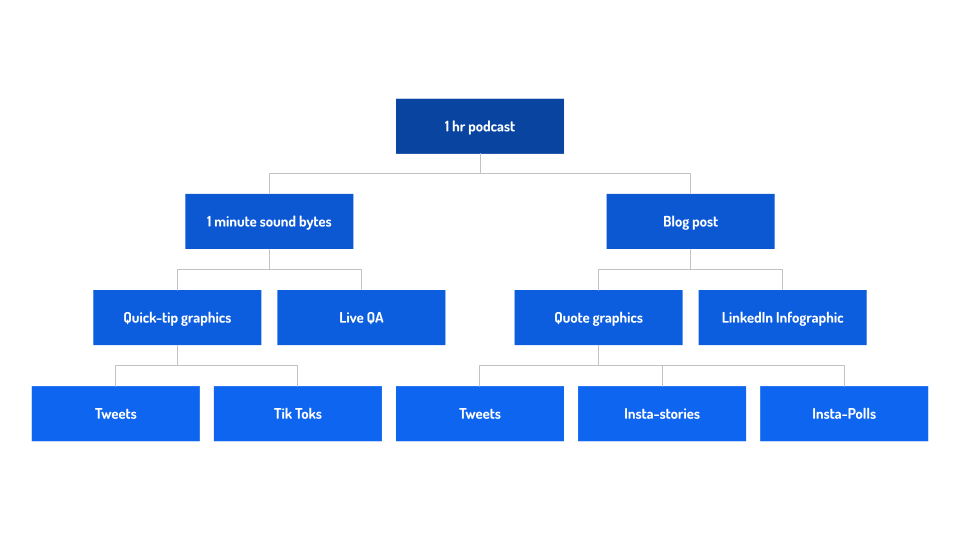You’ve likely heard the adage “content is king (or queen)” from your marketing team, and it’s true. Content has the ruling power to connect and engage your audience in meaningful ways. Content creation doesn’t discriminate — no matter your company size, industry, or marketing strategy, your customers or members likely expect you to tell stories through photos, videos, images, and sound bytes.
All that said, the pressure to create good content in high quantities can feel overwhelming. For example, social benchmarks say that, on average, you should be posting to Twitter 15 times per day, Facebook and LinkedIn once a day, and Instagram twice a day. This begs the question, where in the world is all of this content coming from? How do you dedicate time and resources towards content and not just any content, content that will drive engagement and ultimately provide ROI?
If you’re feeling like a mere plebeian living in the land of King Content, I’ve got some easy hacks that will help alleviate some of the pressure around content creation.
Macro vs. Micro Content
One way content can be categorized is into macro and micro buckets. Macro content can be classified as long-form. Think a full-length presentation, or a podcast, or a video. These, my friends, are content gold mines. According to a Hubspot survey, over 70% of people only skim blog articles, podcasts, and other long-form content. Over 50% give their full attention to video content and social media posts. These stats don’t negate the importance of macro content but rather increase the importance of breaking content down into smaller, digestible pieces. When taking an omni-channel, multimedia content approach, you can slice and dice long-form content in several different ways to make it feel new to users and help get your message across. Check out the sample breakdown we did for how one 1-hour podcast can be broken down across channels:

Content Curation
When it comes to content, there’s no need to reinvent the wheel. The “sharing” feature was invented for a reason. There are so many ways you can add your own spin to existing content and alleviate the pressure from your internal content creators to have all of the new ideas. This is called content curation, and it’s the saving grace for content teams everywhere. Here are some ways you can curate content for your brand:
- Repost content and add your own take: See a blog that you could shed new light on? Is there a perspective that your brand could add to an existing piece of content? Repost content with your own unique spin to assert your thought leadership. This not only shows that your brand can critically think about industry topics but also asserts relevance in the industry.
- Share user-generated content (UGC): In this day and age, people give you free content all the time. Social platforms have allowed for brand advocacy on a new level. Sift through your tagged photos, or hashtags related to your brand, and you’ll find brand ambassadors that you didn’t know you had. With the correct permissions, these pieces of content bring a level of authenticity and relatability to your brand that your created content might not be able to.
- Resurface your own created content: If we know anything about history, it’s that it repeats itself. Trends are always making a comeback (take Doc Martens for example, or, unfortunately, low rise jeans). While some content is rendered irrelevant with time, other pieces of content are evergreen and may once again have their time in the limelight. Look through your old blogs, podcasts, and articles to see if there’s something that may feel hyper relevant in today’s context.
When curating content, it’s key to ensure that you are giving credit where it’s due and/or obtaining the proper consent before sharing, especially when it comes to user-generated content. On social, this can be done through direct messages or asking for consent in the comments.
Find Your Frequency
Industry frequency averages by channel can be intimidating. You might look at the numbers in the first paragraph for social channels and think “There’s just no way we can hit those.” I’m here to bring you some good news: you don’t have to. Each industry is unique, just like each channel is unique. Not to mention, preference for content consumption is constantly changing. My advice for finding your content sweet spot? Using those averages as a guide along with trial and error until you find what works for you. Pay close attention to engagement rates and conversions at various posting frequencies and adjust your content calendar accordingly. At the end of the day, content creation is about giving the people what they want, so listen to the people! In that same vein, don’t be afraid to use polls and surveys to ask your audience members how often they want to hear from you and what kind of content they’re looking for.
Content creation can be intimidating but when you release the expectation that each piece of content needs to be shiny and new, you learn to polish off the good stuff that exists and make it glow in a new light. Content is the beacon of your brand, and when you have a strong strategy in place for creating and curating it, you strengthen the relationship with your audience. If you need any help putting a content strategy in place, or generating content for your channels, give us a call.
